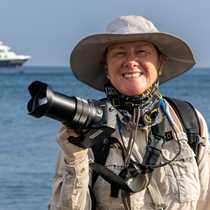Isabela & Fernandina Islands
Calm seas and a clear horizon greeted us on rising. We were north of the equator, having crossed over the line for the first time around five in the morning. Needless to say I didn’t wake anyone up then. But by six o’clock, the volcanoes of Isabela were visible and the search was on. The Galápagos petrel, shearwater and storm petrel were all present, but everyone was hoping for something slightly larger.
We got “large” about an hour later when a blue whale, the largest animal on earth showed itself from the depths just off our bow. The whale was obviously feeding because its erratic course was unpredictable, although it stayed at a steady five to seven breathes on the surface, followed by a regular five to six minutes underwater. The krill it feeds on was probably a couple hundred feet down, though the ocean bottom was around 9,000 feet in this area. Twice it showed the spectacular flukes as it sounded; once very early on in our hour of watching, and the last as we said goodbye. Unmistakable in all its features, the beautiful animal continued on, seemingly oblivious of our presence.
The rest of the morning didn’t let us down either. King Neptune put in an appearance to make sure the pollywogs (and there were many) turned into shellbacks on our crossing of the equator line. Ocean sunfish and turtles greeted the new initiates during the Zodiac ride, and penguins and flightless cormorants put in additional appearances underwater during the snorkeling expedition later. Literally dozens of Pacific green sea turtles hung suspended in the water of the bay of Punta Vicente Roca, Isabela Island.
We have onboard a group from the Harvard Museum of Natural History, and their Wenfei Tong spoke by popular demand of Alfred Russell Wallace before our afternoon explorations of Punta Espinosa on Fernandina Island.
The beginning of time in the Galápagos, Fernandina is often described as the embodiment of the first islands born of fire here in the eastern Pacific Ocean. “Primordial” was an expression heard after we set foot on this rough lava coast. Yet surprisingly full of life; marine iguanas sun-bathed; Sally Lightfoot crabs nibbled and tip-toed; sealions suckled and slept; hawks preened and searched; cormorants spread their wings and dried; we walked, watched and were filled with wonder.
Calm seas and a clear horizon greeted us on rising. We were north of the equator, having crossed over the line for the first time around five in the morning. Needless to say I didn’t wake anyone up then. But by six o’clock, the volcanoes of Isabela were visible and the search was on. The Galápagos petrel, shearwater and storm petrel were all present, but everyone was hoping for something slightly larger.
We got “large” about an hour later when a blue whale, the largest animal on earth showed itself from the depths just off our bow. The whale was obviously feeding because its erratic course was unpredictable, although it stayed at a steady five to seven breathes on the surface, followed by a regular five to six minutes underwater. The krill it feeds on was probably a couple hundred feet down, though the ocean bottom was around 9,000 feet in this area. Twice it showed the spectacular flukes as it sounded; once very early on in our hour of watching, and the last as we said goodbye. Unmistakable in all its features, the beautiful animal continued on, seemingly oblivious of our presence.
The rest of the morning didn’t let us down either. King Neptune put in an appearance to make sure the pollywogs (and there were many) turned into shellbacks on our crossing of the equator line. Ocean sunfish and turtles greeted the new initiates during the Zodiac ride, and penguins and flightless cormorants put in additional appearances underwater during the snorkeling expedition later. Literally dozens of Pacific green sea turtles hung suspended in the water of the bay of Punta Vicente Roca, Isabela Island.
We have onboard a group from the Harvard Museum of Natural History, and their Wenfei Tong spoke by popular demand of Alfred Russell Wallace before our afternoon explorations of Punta Espinosa on Fernandina Island.
The beginning of time in the Galápagos, Fernandina is often described as the embodiment of the first islands born of fire here in the eastern Pacific Ocean. “Primordial” was an expression heard after we set foot on this rough lava coast. Yet surprisingly full of life; marine iguanas sun-bathed; Sally Lightfoot crabs nibbled and tip-toed; sealions suckled and slept; hawks preened and searched; cormorants spread their wings and dried; we walked, watched and were filled with wonder.




